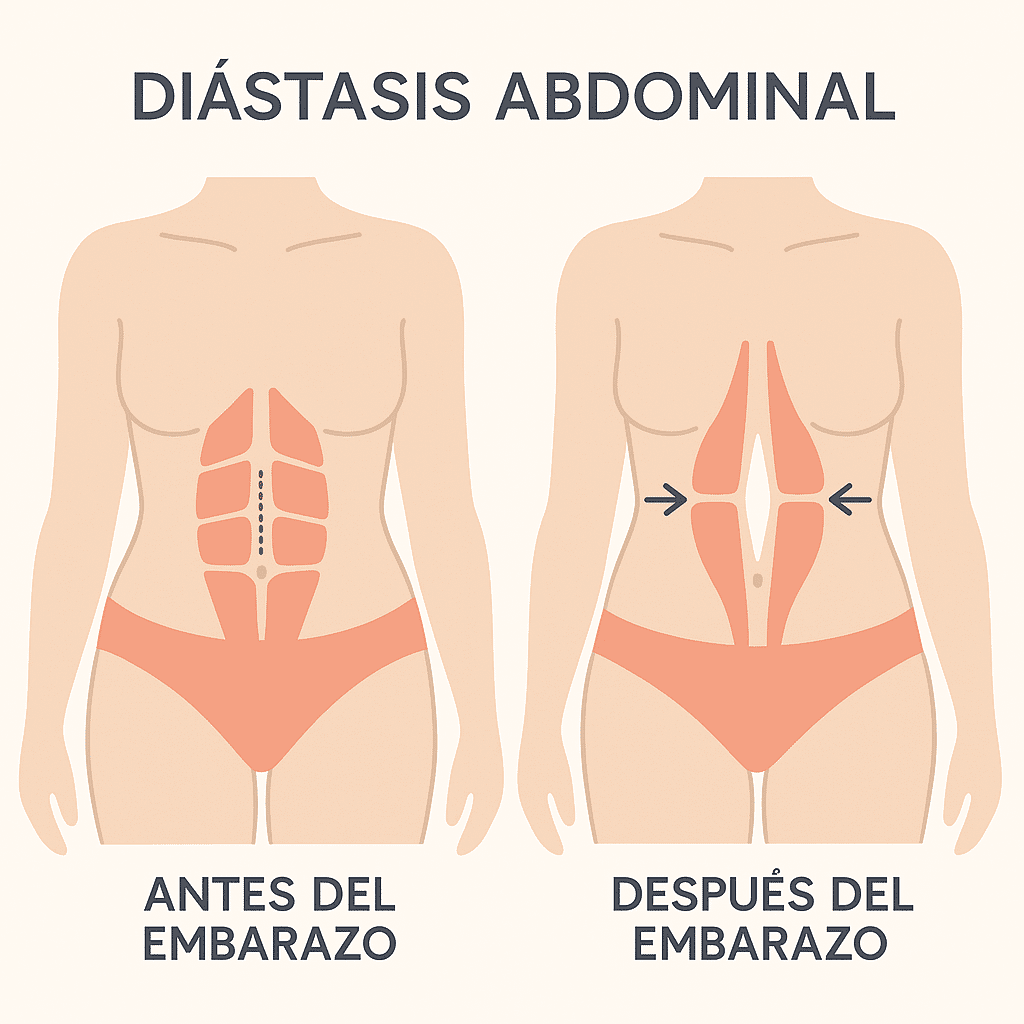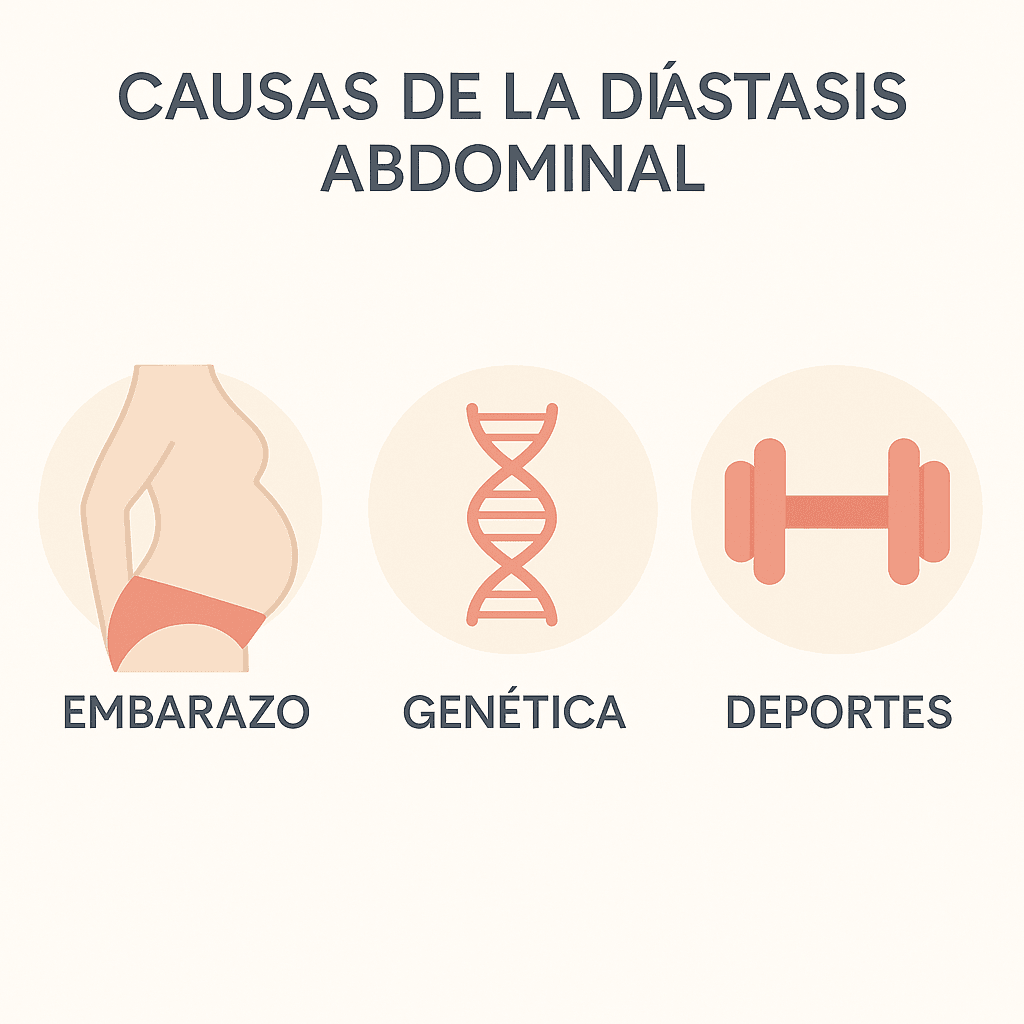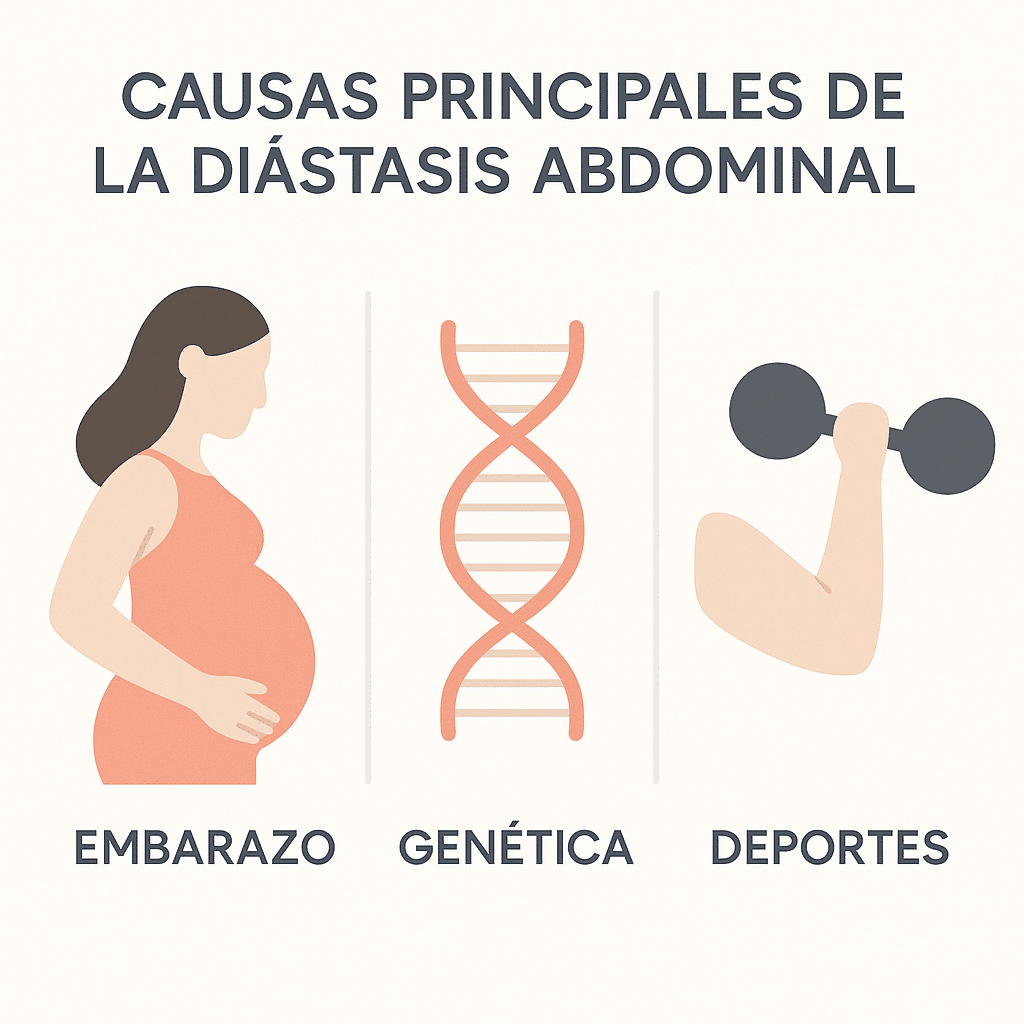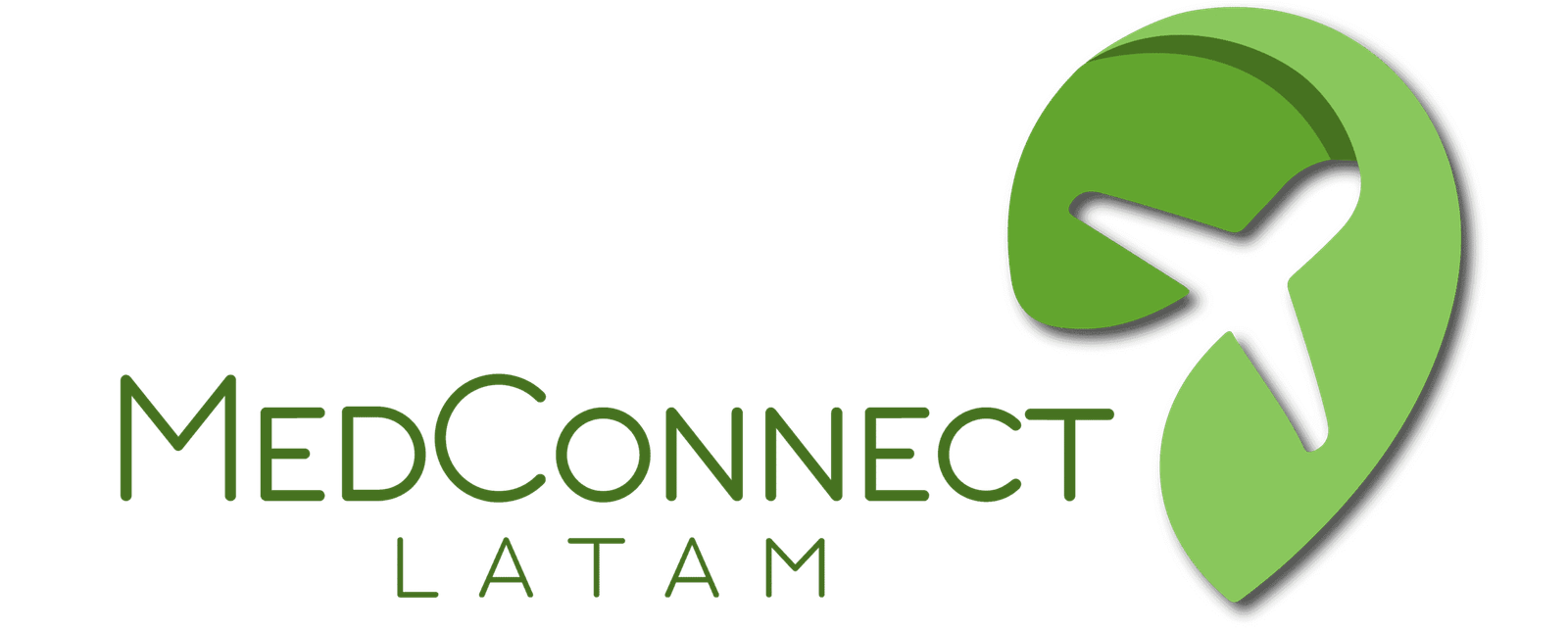Diastasis recti ('mommy tummy') 2025: Causes, recovery, and when to opt for surgery
What is abdominal diastasis?
Medical definition updated in 2025
Abdominal diastasis is the abnormal separation of the rectus abdominis muscles, which are normally connected in the center by a band of connective tissue called the linea alba. This condition occurs when the linea alba stretches and loses tension, causing the muscles to separate and create a visible or palpable gap in the midline of the abdomen. In 2025, abdominal diastasis was classified as an abdominal wall disorder, and its study has been updated thanks to the use of high-resolution dynamic ultrasound, which allows for the evaluation not only of the degree of separation but also of tissue quality and functionality. It is not exclusively a cosmetic concern: it can have significant functional implications such as core weakening, postural instability, lower back pain, and even mild respiratory dysfunction due to lack of support in the thoracic-abdominal region.

Difference between functional and pathological diastasis
Functional diastasis is a condition in which, despite the separation, the person maintains core strength and control and does not experience significant discomfort. This type usually responds well to conservative treatment, such as physical therapy or hypopressive exercises, especially in the early postpartum phase. In contrast, pathological diastasis involves more severe structural deterioration. The linea alba is weakened, thin, or even almost nonexistent, producing symptoms such as constant abdominal protrusion, discomfort when walking or carrying weight, and functional weakness. In these cases, surgical options such as rectus plication, either conventional or laparoscopic, are considered. A correct diagnosis by a specialized professional is essential to determine the most appropriate path to recovery, which can range from a guided exercise routine to reconstructive surgery.
Main causes of abdominal diastasis

Pregnancy and hormonal changes
During pregnancy, the progressive growth of the uterus pushes the rectus muscles sideways. Simultaneously, hormones such as relaxin and progesterone act on connective tissues to make them more flexible, facilitating the stretching necessary to accommodate the baby. However, in some women, this stretching exceeds the tissue's recovery capacity, especially in the case of multiple pregnancies, large babies, or closely spaced births. Recent studies have also indicated that the type of delivery may play a role: multiple or prolonged cesarean sections can further weaken the abdominal wall, especially if there is no adequate postpartum rehabilitation. Therefore, preventive physical therapy programs during pregnancy are gaining importance in 2025.
Genetic factors and predisposition
Genetics influences the quality of the collagen that forms the linea alba. People with connective tissue disorders, such as Ehlers-Danlos syndrome, are at greater risk of developing diastasis recti, even if they have not been pregnant or are not exposed to significant abdominal pressure. Furthermore, some research has identified a familial pattern in women who experience severe postpartum diastasis, indicating that genetic inheritance may affect the elasticity and resilience of abdominal muscles.
High-impact physical activities and their role
High-impact sports, excessive weight training without proper technique, and poorly executed exercises that generate a sudden increase in intra-abdominal pressure (such as classic sit-ups or poorly performed burpees) can aggravate or even cause diastasis recti in predisposed individuals. In men, this is one of the main causes. Therefore, health professionals recommend a safe progression of physical exercise, abdominal breathing training, and avoiding movements that produce the famous "dome" or bulge in the midline of the abdomen during exercise.
Common symptoms and signs in women and men
Visible changes in the abdomen
The most characteristic sign of diastasis recti is a raised or bulging sensation in the center of the abdomen, which appears when performing movements such as sitting up, coughing, or lifting weights. This bulge is often described as a "ridge" or "dome" in the midline, which many women notice during pregnancy and which persists after delivery if not corrected. In thinner women, it may be more visually evident, while in those with more abdominal fat, it may go unnoticed until symptoms appear. In men, this sign is often confused with excess fat or bloating, delaying diagnosis.
Lower back pain and muscle weakness
Diastasis recti weakens the body's core stability, resulting in chronic lower back pain, difficulty exercising, and increased muscle fatigue. The core stops functioning as a stabilizing belt, and this can lead to compensations in the lower back, hips, and even the knees. Additionally, many women report a feeling of emptiness or lack of strength in the abdomen, which affects even everyday tasks such as bending over, carrying their children, or getting out of bed. In athletes, this weakness can compromise performance and increase the risk of injury.
Impact on the pelvic floor and posture
When the core loses its functionality, the pelvic floor, which works in synergy with the abdominal muscles and diaphragm, is also affected. This can lead to problems such as urinary incontinence, a feeling of pelvic pressure, and, in more severe cases, organ prolapse. Posturally, the lack of abdominal tension alters the body's axis. Many people adopt compensatory postures—such as an anterior pelvic tilt or lumbar hyperlordosis—which aggravates the pain and can cause secondary joint discomfort. Postural rehabilitation should be part of the overall treatment for diastasis recti.
Diastasis recti in men: a lesser-known problem
Causes in men: sports, obesity and surgeries
Although it is more common in women due to pregnancy, abdominal diastasis recti can also occur in men, albeit with less social and diagnostic visibility. In 2025, healthcare professionals are paying greater attention to this condition, which, although silent, impacts the quality of life of many men. The most common causes include excessive weight lifting, exercises that generate abdominal pressure without proper technique, abdominal obesity—which exerts continuous tension on the muscle wall—and previous surgeries that weaken the integrity of the connective tissue. The problem is compounded by the fact that many men do not seek medical help until they experience noticeable physical discomfort or hernias, which complicates conservative treatments. Awareness of this condition is increasing thanks to specialized clinics such as
MedConnect Latam, which also offer personalized solutions for men.
Therapeutic approach similar or different to that of women
The therapeutic approach for men follows the same principles of functional rehabilitation, deep core strengthening, and postural correction, but with necessary anatomical and lifestyle adaptations. For example, many men require respiratory retraining and greater emphasis on safe sports technique. When symptoms affect functionality or there is severe separation, surgery is considered. Surgery for men may involve simple suture repair or mesh reinforcement, depending on the presence of associated hernias. The decision should be made in conjunction with a specialized surgeon after a thorough clinical evaluation and imaging studies.
Emotional impact and self-esteem
Psychological support and support groups
Diastasis recti is not just a physical condition; it can also profoundly affect self-esteem, especially in women who have just gone through a life-changing process like pregnancy. Many report frustration at finding their abdomen isn't the same as before, even with diet or exercise. This can lead to feelings of shame and isolation, and in some cases, trigger or worsen postpartum anxiety and depression. Emotional support is crucial. In 2025, the role of perinatal psychologists, body image coaches, and online or in-person support groups that allow for the validation of emotions and the sharing of recovery processes will be highlighted.
How to improve your relationship with your body after childbirth
Recovering the relationship with one's body involves more than an aesthetic goal. It's about accepting the natural changes of a life stage, understanding that the body has done something extraordinary, and, from that place, beginning a respectful and functional recovery. Practices such as postnatal yoga, therapeutic dance, or simply mindful exercise can facilitate this journey. The key lies in comprehensive professional support and surrounding oneself with an empathetic support network that doesn't judge, but rather accompanies.
Frequently Asked Questions (FAQ)
Can diastasis close on its own?
In some cases, especially in first-time mothers with a mild separation, the body can partially regenerate the linea alba. However, most people will require physical therapy and targeted exercises to achieve a full and functional recovery.
Is it dangerous if left untreated?
Yes. Although it may seem purely aesthetic, untreated diastasis recti can lead to hernias, chronic pain, pelvic floor dysfunction, and loss of core strength. It is always recommended to consult a specialist if diastasis is suspected.
Can I do sit-ups with diastasis recti?
Not without supervision. Traditional sit-ups are contraindicated. The recommendation is to follow an exercise program guided by physical therapists specializing in pelvic floor and postpartum or sports recovery.
Conclusion: Towards an informed and safe recovery

Diastasis recti is a treatable and increasingly better understood condition. With early diagnosis, professional support, and quality surgical options, such as those offered at
MedConnect LatamIt is possible to regain both functionality and confidence in your body. Listening to your body, educating yourself about your options, and surrounding yourself with a specialized team can make a difference in your physical and emotional well-being. You are not alone. Recovery is possible.


 Diastasis recti is a treatable and increasingly better understood condition. With early diagnosis, professional support, and quality surgical options, such as those offered at MedConnect LatamIt is possible to regain both functionality and confidence in your body. Listening to your body, educating yourself about your options, and surrounding yourself with a specialized team can make a difference in your physical and emotional well-being. You are not alone. Recovery is possible.
Diastasis recti is a treatable and increasingly better understood condition. With early diagnosis, professional support, and quality surgical options, such as those offered at MedConnect LatamIt is possible to regain both functionality and confidence in your body. Listening to your body, educating yourself about your options, and surrounding yourself with a specialized team can make a difference in your physical and emotional well-being. You are not alone. Recovery is possible. 

